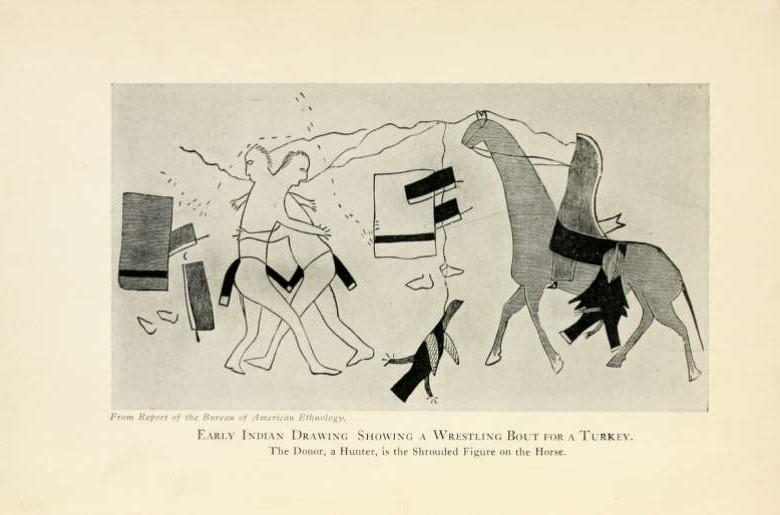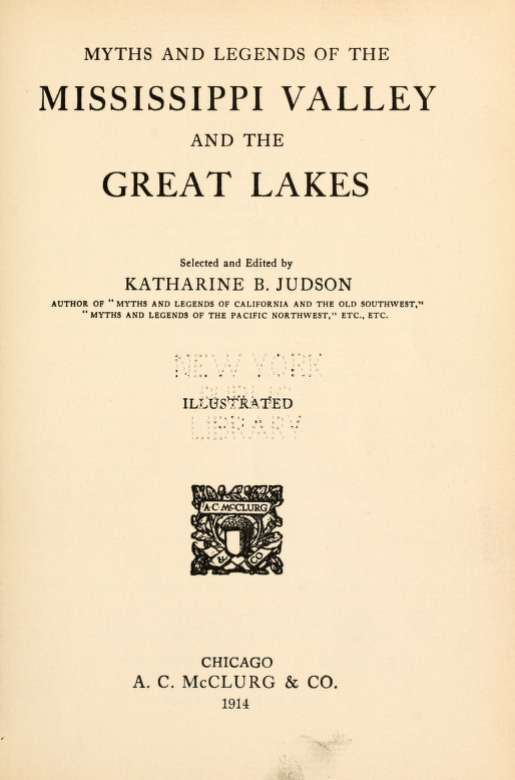
Katharine B. Judson.
“Preface.”
Myths and Legends of the Missippi Valley and the Great Lakes.


MYSTERY,
magic, and
manitoes
abound in the land of Hiawatha, in the land of the Ojibwas, among the green islands, graceful and beautiful, lying amidst the dancing blue waters when the sun shines over
Gitche Goomee,
the Great Water. Manitoes, great and mighty, lived in the cool depths of the mighty forests, in the rivers and lakes, and even in the snows of winter. And adventures there were in those early days amongst these islands of the North, when manitoes directed the affairs of men.
But the animal fathers lived upon the earth before there came the “two-legged walkers.” There were many animals. There were many beavers. It was the beavers who made Gitchee Gomee, the Great Water. They made it by building two dams. The first they built at the Grand Sault, and the second was five leagues below. When Great Hare came up the river, he said, “This must not be so.” Therefore he stepped upon the first dam. But he was in haste. He did not break it down; therefore there are now great falls and whirlpools at that place. But at the second dam, Great Hare stepped upon it mightily; therefore there are now few falls and only a little swirling water at that place. Great Hare was very mighty. When he chased Beaver he stepped across a bay eight leagues wide.
Around Michilimackinack was the land of Great Hare. There, amongst the green islets, under the cool shade of wide spreading trees, where fish leaped above the rippling waters, he made the first fish net. He made it after watching Spider weave a web for catching flies.
It was Wenibojo, who, in Ojibwa land, discovered the wild rice and taught the Indians to use it. He first pointed out the low grassy; islands in the lakes, waving their bright green leaves and spikes of yellowish-green blossoms. He showed them how to cut paths through the wild-rice beds before the grain was ripe, and later, to beat it into their canoes. He told them always to gather the wild rice before a storm, else the wind would blow it all into the water. Therefore the Indians use wild rice in all their feasts. They even taught the white men to use it.
When the snows of winter lay deep upon the forests of the North, when ice covered lakes and rivers, then the story tellers of the Ojibwas, as of all other Indian tribes, told the tales of the olden times, when manitoes lived upon the earth, and when the animal fathers roamed through the forest. But such stories are not told in summer. All the woods and shores, all the bays and islands, are, in summer, the home of keen-hearing spirits, who like not to have Indians talking about them. But when the deep snows come, then the spirits are more drowsy. Then the Indians, when North West rattles the flaps of the wigwams, and wild animals hide in the shelter of the deep forest, tell their tales. All winter they tell them, while the fires burn in the wigwams — tell them until the frogs croak in the spring.
Tales they tell of how Gitche Manito, the Good One, taught the Indians how to plant the Indian corn, how to .strip and bury Mondamin, and how to gather the corn in the month of falling leaves, that there may be food in the camps when the snows of winter come. Tales they tell of Gitche Manedo, the Evil One, who brings only distress and sickness — tales of the land of Hiawatha. Mystery and magic lay all about them.
It is a far cry from the stories of the North along the banks of the Mississippi, from that land of long winters, through the country of the mound builders, to the sunnier Southland; yet from north to south, around the glimmering Indian fires, grouped eager men and women and children, listening to the story tellers.
But quite different are the tales of the Southland — of the Cherokees, Biloxis, and Chitimachas. They are stories of wild turkeys, of persimmons and raccoons, and of the spirits which dwell in the mountain places where none dare go. Stories also are they of Brer Rabbit and the tar wolf, which came from Indian slaves working in the fields in early days, through the negro slaves working beside them, to the children of the white men.
It is a loss to American literature that so much of the legendary history of these Indian tribes has gone, beyond hope of recovery. Exquisite in color, poetical in feeling, these legends of sun, moon, and stars, of snow, ice, lightning, thunders, the winds, the life of the forest birds and animals about them, and the longing to understand the why and the how of life — all which we have only in fragments. Longfellow’s work shows the wonderful beauty of these northern legends, nor has he done violence to any of them in making them poetical. His picture of the departure of Hiawatha, the lone figure standing stately and solemn, as the canoe drifted out towards the glowing sunset, while from the shore, in the shadow of the forest, came the low Indian chant, mingling with the sighing of the pine trees, is truely Indian. For the mystical and poetical is strong in the Indian nature.
As in all the other volumes of this series, no effort has been made to ornament or amplify these legends in the effort to make them “literary,” or give them “literary charm.” They must speak for themselves. What editing has been done has been in simplifying them, and freeing them from the verbose setting in which many were found. For in this section of the country, settled before it was realized that there was an Indian literature, the original work of noting down the myths was very imperfectly done.
Thanks are due to the work of Albert E. Jenks, on the wild-rice Indians of the upper lakes; to James Mooney, for the myths of the Cherokees; to George Catlin, for some of the upper Mississippi legends; to the well-known but almost inaccessible work of School-craft, and to others.
K. B. J.
Notes
- Manitoes. The manitou is a spirit in the Algonquian groups of Native Americans. It is a kind of animism in which every thing, both living and inanimate, has its own manitou.
- Gitche Goomee. Gitche Gomee is Lake Superior [Judson’s note].
- Wenibojo. Wenibojo is only a variation of the name also given as Manabush. Both are identical with Hiawatha. [Judson’s note].
Text prepared by:
- Jacob Nelson
- Bruce R. Magee
- Kaitlyn Plauche
Source
Judson, Katharine Berry. Myths and Legends of the Mississippi Valley and the Great Lakes. Chicago: A. C. McClurg & Co., 1914. Internet Archive. Web. 22 June 2007. 20 November 2013. <https:// archive.org/ details/ myths legends ofmi00juds>.
